
#Xchat azure mac mac os x
Mac OS X is a completely new implementation of the Macintosh operating system, featuring state of the art technology throughout, including an entirely new user interface called “Aqua”.

#Xchat azure mac software
Pre-release versions of Mac OS X will be delivered to Macintosh software developers by the end of this month, and will be commercially released this summer. Steve Jobs demonstrated Mac OS X to an audience of over 4,000 people during his Macworld Expo keynote today, and over 100 developers have pledged their support for the new operating system, including Adobe and Microsoft. Same case is for oftc network configuration.Īs part of establishing the connection, information about our Let’s Encrypt certificate will be displayed, after which connection will be established and you’ll be automatically logged into all chatrooms.MACWORLD EXPO, SAN FRANCISCO-January 5, 2000-Reasserting its leadership in personal computer operating systems, Apple® today unveiled Mac® OS X, the next generation Macintosh® operating system. “freenode” in this case must first be created as part of ZNC webadmin configuration, mentioned in “step 4”. “freenode” is ZNC network name, and “password” is ZNC password. On “Connecting” tab “Server password” field needs to be filled in following format: johndoe/freenode:password On “General” tab of our newly created server, hostname for our server should be the sub/domain we’ve setup as part of “Step 1”, and port number should be the one we defined in “Step 4”, SSL checkbox must be checked. In my setup I automatically connect to freenode and oftc networks, so I created two for local network and two for external network usage, later is the one we’re concentrating on. In this example I’ll use XChat Azure on MacOS, and same procedure should be identical for HexChat/XChat clients on any other platform.Īltough all information is picked up from ZNC itself, user details will need to be filled in. Sudo /var/packages/znc/scripts/start-stop-status stop & sudo /var/packages/znc/scripts/start-stop-status start Sudo cat /usr/syno/etc/certificate/_archive/JeRh3Y/.pem > /usr/local/znc/var/znc.pem Once it’s determined which certifiate is the one we want use, generate. In case you have multiple certificates, based on date your certificate was created, you can determine in which directory is your newly generated certificated stored, i.e: drwx- 2 root root 4096 Sep 10 12:57 JeRh3Y

On Synology, Let’s Encrypt certificates are stored and located on: /usr/syno/etc/certificate/_archive/ pem file from LetsEncrpyt certificate for ZNC to use ZNC Webadmin is now available via HTTPS on external network for the sub/domain you setup as part of Step 1, or in my case:Īs part of this step, in ZNC webadmin I’d advise you to create IRC servers and chatrooms you would like to connect to later. Where sub/domain created in “Step 1” needs to be point to ZNC SSL/TLS port on localhost, i.e: Reverse Proxy can be created in: DSM: Control Panel > Application Portal > Reverse Proxy > Create This can be done by creating a reverse proxy.Īs part of this, you need to know which port has been allocated for SSL in ZNC Webadmin, i.e: Now we want to bind our sub/domain created in “Step 1” to ZNC webadmin, and secure external access to it. To successfuly authenticate newly added source, under “General” tab, “Trust Level” should be set to “Any publisher”Īs part of installation process, ZNC config will be run with most sane/useful options and admin user will be created allowing you access to ZNC webadmin. Which can simply be done by adding new package sources: Name: SynoCommunity ZNC can be installed using Synology’s Package Center, if community package sources are enabled. In latest version, all of these problems have been fixed and couple of new features have been added. Mainly due to some problems with package in past, where ZNC wouldn’t start automatically on boot which lead to creating projects like: synology-znc-autostart.

In case you already have ZNC installed, I suggest you remove it and do a clean install. Add a new certificate > Get a certificate from Let's Encryptįollowed by adding domain name A record was created for in Step 1, i.e:Īfter certificate is created, don’t forget to configure newly created certificate to point to correct domain name, i.e:


 0 kommentar(er)
0 kommentar(er)
